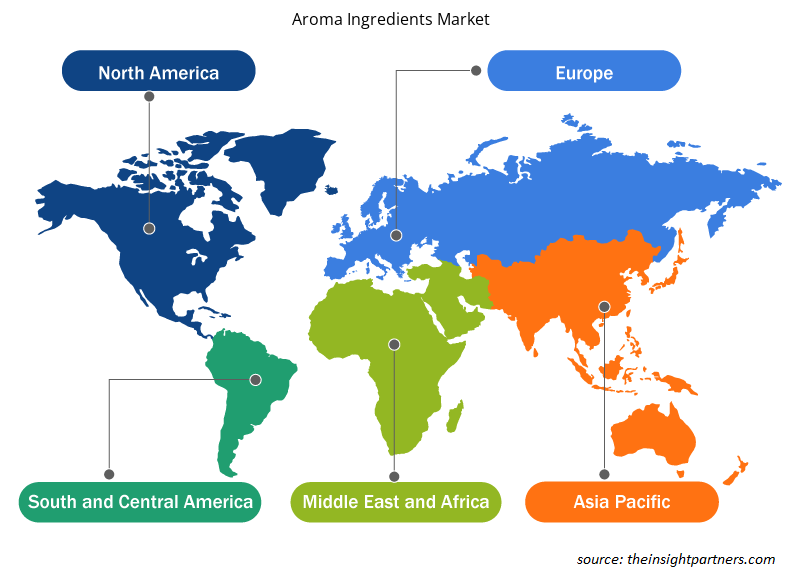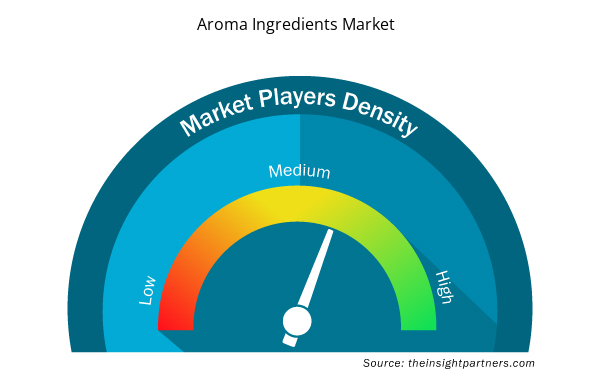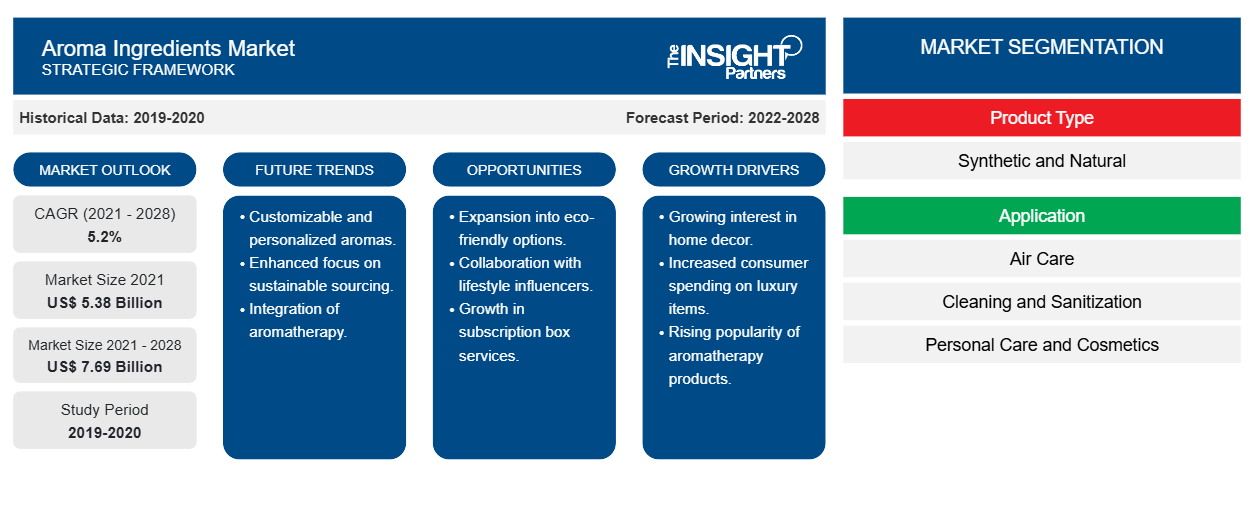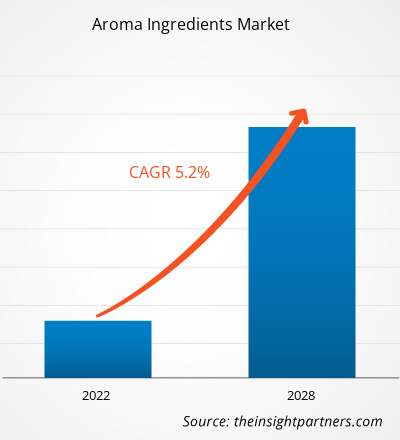Il mercato degli ingredienti aromatici è stato valutato a 5.376,90 milioni di dollari nel 2021 e si prevede che raggiungerà i 7.692,62 milioni di dollari entro il 2028; si prevede una crescita a un CAGR del 5,2% dal 2021 al 2028.
Gli ingredienti aromatici sono fondamentalmente composti complessi che vengono aggiunti ai cosmetici e alla cura della persona, nonché alla cura della casa e ad altri prodotti per conferire la fragranza desiderata. Gli ingredienti aromatici possono essere naturali o sintetici. Gli ingredienti aromatici includono oli essenziali, attar, isolati, oleoresine, assoluti, sostanze chimiche aromatiche e ingredienti aromatici speciali, tra gli altri. La transizione del settore della cura della persona e dei cosmetici ha fornito numerose nuove opportunità di crescita per il mercato degli ingredienti aromatici e si prevede che guiderà il mercato nel periodo di previsione.
Nel 2020, l'Asia-Pacifico ha dominato il mercato globale degli ingredienti aromatici e si prevede che manterrà il suo predominio durante il periodo di previsione. Negli ultimi anni c'è stata una maggiore consapevolezza riguardo all'aspetto personale tra gli individui nella regione dell'Asia-Pacifico, che ha portato a una domanda crescente di prodotti cosmetici, con conseguente crescita del mercato dei cosmetici nella regione. Il desiderio di un'immagine personale presentabile tra i consumatori asiatici ha portato a una maggiore consapevolezza delle abitudini di igiene personale. La crescente preoccupazione dei consumatori per la propria salute e igiene ha portato a una maggiore domanda di prodotti per la cura della persona, cosmetici e prodotti per la pulizia e l'igienizzazione che forniscono fragranza o aroma, a loro volta, portando a una maggiore domanda di ingredienti aromatici. Inoltre, l'Asia-Pacifico è composta da paesi come India e Cina che si sono trasformati in centri di produzione per numerosi mercati di utilizzo finale che utilizzano ingredienti aromatici. La popolazione crescente nei paesi in via di sviluppo dell'Asia-Pacifico insieme all'aumento del reddito disponibile hanno portato a una maggiore domanda di prodotti per la cura della persona e cosmetici. La domanda ha portato a una maggiore produzione interna di prodotti per la cura della persona, con conseguente aumento del consumo di ingredienti aromatici nella regione.
Personalizza questo report in base alle tue esigenze
Riceverai la personalizzazione gratuita di qualsiasi report, comprese parti di questo report, o analisi a livello nazionale, pacchetto dati Excel, oltre a usufruire di grandi offerte e sconti per start-up e università
- Scopri le principali tendenze di mercato in questo rapporto.Questo campione GRATUITO includerà analisi di dati che spaziano dalle tendenze di mercato alle stime e alle previsioni.
Approfondimenti di mercato
Varie applicazioni dell'ingrediente aromatico
L'uso crescente di ingredienti aromatici in varie applicazioni come la cura dell'aria, profumi e fragranze raffinate, prodotti per la casa, alimenti e bevande e prodotti farmaceutici sta portando a una domanda crescente di ingredienti aromatici. Le fragranze raffinate includono i principali campi di applicazione, come profumi, colonie, spray per il corpo e deodoranti. Gli ingredienti aromatici sono uno degli elementi essenziali utilizzati nelle formulazioni di fragranze raffinate. Insieme a questo, gli ingredienti aromatici vengono utilizzati in prodotti per la casa come detergenti, detersivi per le mani e per i piatti, prodotti per la cura del bucato e ammorbidenti, salviette e coloranti acquosi. Pertanto, un'applicazione crescente di ingredienti aromatici guiderà la crescita del mercato degli ingredienti aromatici.
Informazioni sul tipo di prodotto
In base al tipo di prodotto, il mercato degli ingredienti aromatici è segmentato in naturale e sintetico. Nel 2020, il segmento naturale è stato il segmento in più rapida crescita nel mercato degli ingredienti aromatici. L'aumento delle preoccupazioni per la salute relative alle sostanze chimiche sintetiche ha portato a una maggiore domanda di ingredienti aromatici naturali da parte dei consumatori. Tuttavia, gli ingredienti aromatici sintetici sono relativamente più facili da produrre su larga scala mantenendo la stessa qualità in tutti i lotti. La qualità costante degli ingredienti sintetici ha quindi portato a una quota di mercato maggiore grazie all'uso espansivo soprattutto nel settore dei beni di consumo in rapida evoluzione.
Takasago International Corporation; BASF SE; Firmenich SA; Givaudan SA; International Flavors & Fragrances Inc.; Robertet Group; Symrise; Mane; Zhejiang NHU Co., Ltd.; e Phoenix Aromas & Essential Oils, LLC; sono tra i principali attori che operano nel mercato degli ingredienti aromatici. I principali attori adottano diverse strategie, come fusioni e acquisizioni e lanci di prodotti, per espandere la loro presenza geografica e la loro base di consumatori.
Approfondimenti regionali sul mercato degli ingredienti aromatici
Le tendenze regionali e i fattori che influenzano il mercato degli ingredienti aromatici durante il periodo di previsione sono stati ampiamente spiegati dagli analisti di Insight Partners. Questa sezione discute anche i segmenti e la geografia del mercato degli ingredienti aromatici in Nord America, Europa, Asia Pacifico, Medio Oriente e Africa e Sud e Centro America.

- Ottieni i dati specifici regionali per il mercato degli ingredienti aromatici
Ambito del rapporto di mercato sugli ingredienti aromatici
| Attributo del report | Dettagli |
|---|---|
| Dimensioni del mercato nel 2021 | 5,38 miliardi di dollari USA |
| Dimensioni del mercato entro il 2028 | 7,69 miliardi di dollari USA |
| CAGR globale (2021 - 2028) | 5,2% |
| Dati storici | 2019-2020 |
| Periodo di previsione | 2022-2028 |
| Segmenti coperti | Per tipo di prodotto
|
| Regioni e Paesi coperti | America del Nord
|
| Leader di mercato e profili aziendali chiave |
|
Densità dei player del mercato degli ingredienti aromatici: comprendere il suo impatto sulle dinamiche aziendali
Il mercato degli ingredienti aromatici sta crescendo rapidamente, spinto dalla crescente domanda degli utenti finali dovuta a fattori quali l'evoluzione delle preferenze dei consumatori, i progressi tecnologici e una maggiore consapevolezza dei benefici del prodotto. Con l'aumento della domanda, le aziende stanno ampliando le loro offerte, innovando per soddisfare le esigenze dei consumatori e capitalizzando sulle tendenze emergenti, il che alimenta ulteriormente la crescita del mercato.
La densità degli operatori di mercato si riferisce alla distribuzione di aziende o società che operano in un particolare mercato o settore. Indica quanti concorrenti (operatori di mercato) sono presenti in un dato spazio di mercato in relazione alle sue dimensioni o al valore di mercato totale.
Le principali aziende che operano nel mercato degli ingredienti aromatici sono:
- Società internazionale Takasago
- BASF SE
- Firmenich SA
- Società a responsabilità limitata
- Aromi e fragranze internazionali Inc.
Disclaimer : le aziende elencate sopra non sono classificate secondo un ordine particolare.

- Ottieni la panoramica dei principali attori del mercato degli ingredienti aromatici
Segnala i riflettori
- Tendenze progressive nel settore degli ingredienti aromatici per aiutare i player a sviluppare strategie efficaci a lungo termine
- Strategie di crescita aziendale adottate dalle aziende per garantire la crescita nei mercati sviluppati e in via di sviluppo
- Analisi quantitativa del mercato globale degli ingredienti aromatici dal 2019 al 2028
- Stima della domanda di ingredienti aromatici in vari settori
- Analisi di Porter per illustrare l'efficacia degli acquirenti e dei fornitori che operano nel settore per prevedere la crescita del mercato
- Sviluppi recenti per comprendere lo scenario competitivo del mercato e la domanda di ingredienti aromatici
- Tendenze e prospettive di mercato, insieme ai fattori che guidano e frenano la crescita del mercato degli ingredienti aromatici
- Comprensione delle strategie che sostengono l'interesse commerciale in relazione alla crescita del mercato globale degli ingredienti aromatici, aiutando nel processo decisionale
- Dimensioni del mercato degli ingredienti aromatici in vari nodi del mercato
- Panoramica dettagliata e segmentazione del mercato globale degli ingredienti aromatici nonché delle dinamiche del settore
- Dimensioni del mercato degli ingredienti aromatici in varie regioni con promettenti opportunità di crescita
"Global Aroma Ingredients Market Analysis to 2028" è uno studio specializzato e approfondito del settore chimico e dei materiali con un'attenzione particolare all'analisi delle tendenze del mercato globale degli ingredienti aromatici. Il rapporto mira a fornire una panoramica del mercato con una segmentazione dettagliata del mercato. Il mercato degli ingredienti aromatici è segmentato in base al tipo di prodotto, all'applicazione e alla geografia. In base al tipo di prodotto, il mercato è segmentato in naturale e sintetico. In base all'applicazione, il mercato è segmentato in cura dell'aria, pulizia e igienizzazione, cura della persona e cosmetici, fragranze e profumi raffinati e altri. In base alla geografia, il mercato è segmentato in cinque regioni principali: Nord America, Europa, Asia Pacifico, Medio Oriente e Africa e Sud e Centro America.
Profili aziendali
- Società internazionale Takasago
- BASF SE
- Firmenich SA
- Società a responsabilità limitata
- Aromi e fragranze internazionali Inc.
- Gruppo Robertet
- Simriscita
- Criniera
- Società per azioni Zhejiang NHU Co., Ltd.
- Phoenix Aromas & Essential Oils, LLC.
- Analisi storica (2 anni), anno base, previsione (7 anni) con CAGR
- Analisi PEST e SWOT
- Valore/volume delle dimensioni del mercato - Globale, regionale, nazionale
- Industria e panorama competitivo
- Set di dati Excel



Report Coverage
Revenue forecast, Company Analysis, Industry landscape, Growth factors, and Trends

Segment Covered
This text is related
to segments covered.

Regional Scope
North America, Europe, Asia Pacific, Middle East & Africa, South & Central America

Country Scope
This text is related
to country scope.
Domande frequenti
Aroma ingredients are extensively used to create a wide range of fragrances. Increased healthcare awareness and disposable income have increased demand for consumer goods such as soaps, hand wash, sanitizers, detergents and toiletries. Although, the expansion of the personal care and household care industries significantly contributes to the growth of the aroma ingredient market. Manufacturers focus on increasing natural ingredients for the flavor and fragrance industry to ensure the sustainable sourcing of raw materials.
In 2020, the natural segment accounted for the fastest-growing segment. Natural aroma ingredients are extracted from natural sources, including wood, spices, flowers, and fruits. The rising awareness of the negative effects of synthetic ingredients on human health has increased the demand for natural and bio-based aroma ingredients.
Based on application, personal care and cosmetics are the fastest-growing segments. Aroma ingredients are extensively used in manufacturing personal care and cosmetics products. Continuous technological developments in the personal care and cosmetics sectors and innovations and research and development expenditures are expected to propel the growth of the aroma ingredient market.
In 2020, the synthetic segment accounted for the largest market share. Synthetic aroma ingredients can reproduce a natural and robust scent without compromising the fragrance to manufacture quality fragrance. It has strong demand in manufacturing soaps, shampoos, body lotions, hair conditioners, and other cosmetic and personal care products.
The major players operating in the global metakaolin market are Takasago International Corporation, BASF SE, Firmenich S.A., Givaudan S.A., International Flavors & Fragrances Inc., Robertet Group, Symrise, Mane, Zhejiang NHU Co., Ltd., and Phoenix Aromas & Essential Oils, LLC.
In 2020, Asia Pacific accounted for the largest share of the global aroma ingredient market. The aroma ingredient industry is anticipated to expand faster due to increasing awareness of personal care and hygiene.
Trends and growth analysis reports related to Chemicals and Materials : READ MORE..
The List of Companies - Aroma Ingredient Market
- Takasago International Corporation
- BASF SE
- Firmenich S.A.
- Givaudan S.A.
- International Flavors & Fragrances Inc.
- Robertet Group
- Symrise
- Mane
- Zhejiang NHU Co., Ltd.
- Phoenix Aromas & Essential Oils, LLC.
The Insight Partners performs research in 4 major stages: Data Collection & Secondary Research, Primary Research, Data Analysis and Data Triangulation & Final Review.
- Data Collection and Secondary Research:
As a market research and consulting firm operating from a decade, we have published and advised several client across the globe. First step for any study will start with an assessment of currently available data and insights from existing reports. Further, historical and current market information is collected from Investor Presentations, Annual Reports, SEC Filings, etc., and other information related to company’s performance and market positioning are gathered from Paid Databases (Factiva, Hoovers, and Reuters) and various other publications available in public domain.
Several associations trade associates, technical forums, institutes, societies and organization are accessed to gain technical as well as market related insights through their publications such as research papers, blogs and press releases related to the studies are referred to get cues about the market. Further, white papers, journals, magazines, and other news articles published in last 3 years are scrutinized and analyzed to understand the current market trends.
- Primary Research:
The primarily interview analysis comprise of data obtained from industry participants interview and answers to survey questions gathered by in-house primary team.
For primary research, interviews are conducted with industry experts/CEOs/Marketing Managers/VPs/Subject Matter Experts from both demand and supply side to get a 360-degree view of the market. The primary team conducts several interviews based on the complexity of the markets to understand the various market trends and dynamics which makes research more credible and precise.
A typical research interview fulfils the following functions:
- Provides first-hand information on the market size, market trends, growth trends, competitive landscape, and outlook
- Validates and strengthens in-house secondary research findings
- Develops the analysis team’s expertise and market understanding
Primary research involves email interactions and telephone interviews for each market, category, segment, and sub-segment across geographies. The participants who typically take part in such a process include, but are not limited to:
- Industry participants: VPs, business development managers, market intelligence managers and national sales managers
- Outside experts: Valuation experts, research analysts and key opinion leaders specializing in the electronics and semiconductor industry.
Below is the breakup of our primary respondents by company, designation, and region:

Once we receive the confirmation from primary research sources or primary respondents, we finalize the base year market estimation and forecast the data as per the macroeconomic and microeconomic factors assessed during data collection.
- Data Analysis:
Once data is validated through both secondary as well as primary respondents, we finalize the market estimations by hypothesis formulation and factor analysis at regional and country level.
- Macro-Economic Factor Analysis:
We analyse macroeconomic indicators such the gross domestic product (GDP), increase in the demand for goods and services across industries, technological advancement, regional economic growth, governmental policies, the influence of COVID-19, PEST analysis, and other aspects. This analysis aids in setting benchmarks for various nations/regions and approximating market splits. Additionally, the general trend of the aforementioned components aid in determining the market's development possibilities.
- Country Level Data:
Various factors that are especially aligned to the country are taken into account to determine the market size for a certain area and country, including the presence of vendors, such as headquarters and offices, the country's GDP, demand patterns, and industry growth. To comprehend the market dynamics for the nation, a number of growth variables, inhibitors, application areas, and current market trends are researched. The aforementioned elements aid in determining the country's overall market's growth potential.
- Company Profile:
The “Table of Contents” is formulated by listing and analyzing more than 25 - 30 companies operating in the market ecosystem across geographies. However, we profile only 10 companies as a standard practice in our syndicate reports. These 10 companies comprise leading, emerging, and regional players. Nonetheless, our analysis is not restricted to the 10 listed companies, we also analyze other companies present in the market to develop a holistic view and understand the prevailing trends. The “Company Profiles” section in the report covers key facts, business description, products & services, financial information, SWOT analysis, and key developments. The financial information presented is extracted from the annual reports and official documents of the publicly listed companies. Upon collecting the information for the sections of respective companies, we verify them via various primary sources and then compile the data in respective company profiles. The company level information helps us in deriving the base number as well as in forecasting the market size.
- Developing Base Number:
Aggregation of sales statistics (2020-2022) and macro-economic factor, and other secondary and primary research insights are utilized to arrive at base number and related market shares for 2022. The data gaps are identified in this step and relevant market data is analyzed, collected from paid primary interviews or databases. On finalizing the base year market size, forecasts are developed on the basis of macro-economic, industry and market growth factors and company level analysis.
- Data Triangulation and Final Review:
The market findings and base year market size calculations are validated from supply as well as demand side. Demand side validations are based on macro-economic factor analysis and benchmarks for respective regions and countries. In case of supply side validations, revenues of major companies are estimated (in case not available) based on industry benchmark, approximate number of employees, product portfolio, and primary interviews revenues are gathered. Further revenue from target product/service segment is assessed to avoid overshooting of market statistics. In case of heavy deviations between supply and demand side values, all thes steps are repeated to achieve synchronization.
We follow an iterative model, wherein we share our research findings with Subject Matter Experts (SME’s) and Key Opinion Leaders (KOLs) until consensus view of the market is not formulated – this model negates any drastic deviation in the opinions of experts. Only validated and universally acceptable research findings are quoted in our reports.
We have important check points that we use to validate our research findings – which we call – data triangulation, where we validate the information, we generate from secondary sources with primary interviews and then we re-validate with our internal data bases and Subject matter experts. This comprehensive model enables us to deliver high quality, reliable data in shortest possible time.


 Ottieni un campione gratuito per questo repot
Ottieni un campione gratuito per questo repot